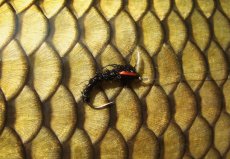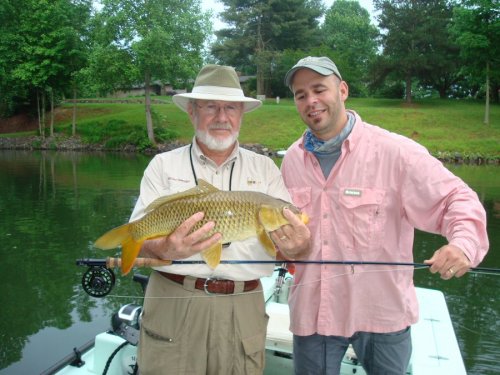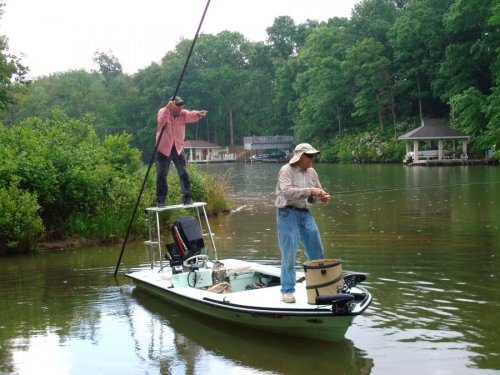What’s the “newest” fly fishing quarry in America? Carp. Carp? That’s right, carp. A fish that has been here for over a hundred and fifty years is finally being appreciated for what it is—an exciting, challenging fish to catch on a fly.
What's the "newest" fly fishing quarry in America? Carp. Carp? That's right, carp. A fish that has been here for over a hundred and fifty years is finally being appreciated for what it is-an exciting, challenging fish to catch on a fly. In most of Europe, carp are the sought-after fish and have been for at least a couple of centuries.
The common carp originally originated from Western Asia and spread throughout China, Siberia and the Danube basin. Carp were spread throughout Europe by monks between the13th and 16th centuries, as a food fish, and has now been introduced to all continents and some 59 countries. In Western Europe, the carp is cultured more commonly as a sport fish although there is a small market as food fish. Wikipedia.
Recently I managed, after two trips, to catch my first carp on a fly rod. I'm no Ernest Hemingway-neither in writing nor fishing-but I like to think I have some rudimentary skills that include casting a fly 30' into a dinner plate and knowing how to fight a 20 lb. saltwater bonito. You can imagine my surprise that it took 2 trips with an excellent local guide before I managed to land my first carp on a fly. The experience was worth it. On light tackle, a carp is a powerful fighter that is capable of making rapid strong runs. And as anyone who has tried to cast to a feeding carp knows, the fish is very wary in shallow water.
But, you say, “Carp? Aren’t they ‘trash’ fish?” Sometimes we Americans don’t appreciate the abundance of possibilities swimming in our lakes, rivers, and streams. Take the blue catfish, for instance. Anyone who’s fought a 50-pound catfish knows this is a powerful quarry that is a thrill to bring to the net. Also very good to eat if you’re not into catch-and-release. Since I’ve found that a fish that big is probably 30 years old, I’ve pretty much stopped killing such a survivor. Fishermen from all over the world come to places like the Santee-Cooper lakes in South Carolina to catch trophy blue and flathead catfish. Locals here should know they can do the same fishing with Robbie Burr (http://www.pdfishingadventures.com) on our nearby Pee Dee River.
Carp were imported to America from Europe in 1877 as a food fish, primarily due to the carp’s ability to survive in almost any situation, including: low water, warm water, poorly oxygenated water, and so on. Carp, like catfish, can gulp air, which gives them an edge in surviving conditions that kill bass and sunfish.
The sterile Nile or "grass" carp used to allegedly control weed growth in lakes and ponds are not the fish I'm talking about. The fish in this article is the "common" carp (Cyprinus carpio), an omnivore and will eat everything from ripe pomegranates to crayfish. And there are many variations of this fish to include one that's still managed to allude my flies, the "bluefin"(small mouth buffalo carp) that swims in schools in rivers like the Pee Dee. These carp are considered some of the most highly evolved fish swimming. When one senses danger, it releases a pheromone that immediately warns the rest of the school. The result of this is: if you scare one fish in the school, you've scared all of them and they won't be back anytime soon...like the rest of the day. Other fish, like trout, bass, and most saltwater species will actually swim alongside a hooked member of their group. Carp don't do that. When you hook one, it's time to crank up the motor and look for another fish, because you won't find any carp within an acre of where you've been fishing.
Fishing with well-know local Charlotte-area guide, Paul Rose, has been a genuine pleasure, for a few reasons. He's one of those individuals who, at least on weekends, does what he loves to do-look for carp. Poling the shoreline and mud or clay flats of local reservoir lakes (and yes, they all have them), Paul scans the shallows for signs of "mud puffs" that mean a carp is actively feeding. And it takes an educated eye to notice the difference between "old mud" that says the carp has left the area; and "fresh mud" that reveals a fish's presence. And Paul enjoys teaching fishermen what to look for and how to fish for carp. Patience. The man has patience...and that's a necessary quality for any guide working with fishermen and women of all degrees of ability.
Once part of a fish, a tail or head or fin, is spotted, then the trick is to put the fly about a half-foot in front of the fish. Closer and the carp will often spook and leave the country…along with all his buddies who he pheremoned his “get outta Dodge” message to. If the fly lands out of the “zone” the carp won’t notice it. This is technical fishing and not for the good ol’ boy who likes to soak bait, drink beer, and sunburn the back of his neck, while darkening the lake with remnants of chewing tobacco. You have to focus to catch a carp on a fly.
If and when the carp sucks in the fly and the fisherman is quick enough to set the hook—too early and the fly is pulled out of the fish’s mouth; too late and the fish spits the fly out—a surprisingly fast run begins. A carp is a powerful fish and lets you know that very soon in the battle. Unlike some game fish that waste energy jumping out of the water, a carp, after a couple of powerful runs, “bulldogs” and makes the fisherman work to bring it in. Even though I’ve caught carp on a stiff 5 wt. rod and a reel that has a good drag, a 7 wt. rod is a better choice, especially for a fisherman used to catching small trout or sunfish. Paul has rods and flies for his fisherman.
When I first called Paul and he mentioned his carp fishing was "Carolina bone fishing," I smirked. I've caught bonefish in the Florida Keys and could see no correlation between the two...until I fished with Paul. He motors to shallow water, climbs up on his poling platform, and scans the water. I walk up to the flush bow deck and scan the water. Paul says, "Fish at 2 o'clock!" and I false cast until I have enough line out. The fly drops too close to the fish and off it goes. Hmmm...the difference between this and bone fishing? I'm on Moss Lake near Shelby, NC; not on a flat off Islamorada Key, FL.
The first trip I fished with Paul we found 8 carp and I couldn't get a decent cast to any of them. Reason? I'd been doing nothing but trout fishing in the Carolina mountains and not distance casting to large spooky carp. After engaging in self abuse and casting in the backyard until I could drop that fly into a paper plate at 30' and more, I went on trip number two with Paul and caught a beautiful-and they are surprisingly colorful-carp on my first cast. Practice, my friends, practice. Since I guide bass fishermen, I know the difference between a successful and a frustrating trip is often how well the fisherman can cast. A lure tossed against the stump of a cypress tree, and allowed to sink slowly into the tannin-stained water, will catch more bass than a lure tossed into the branches of the same tree.
If you plan on going to the Bahamas, the Florida Keys, or Belize, you might want to practice a bit before all that money is spent and you spend your time being frustrated because you've not had any recent practice in this method of fishing. Making a delicate 10 foot presentation to a wild brown trout on the Davidson River and double-hauling into the wind to toss a Clouser or crab fly to a tailing bone 30 yards away are very different situations. Very different.
If you're going:
For an enjoyable and educational trip to catch one of the area’s most challenging gamefish, contact Capt. Paul Rose at:
704.616.6662
www.carolinabonefishing.com.
















